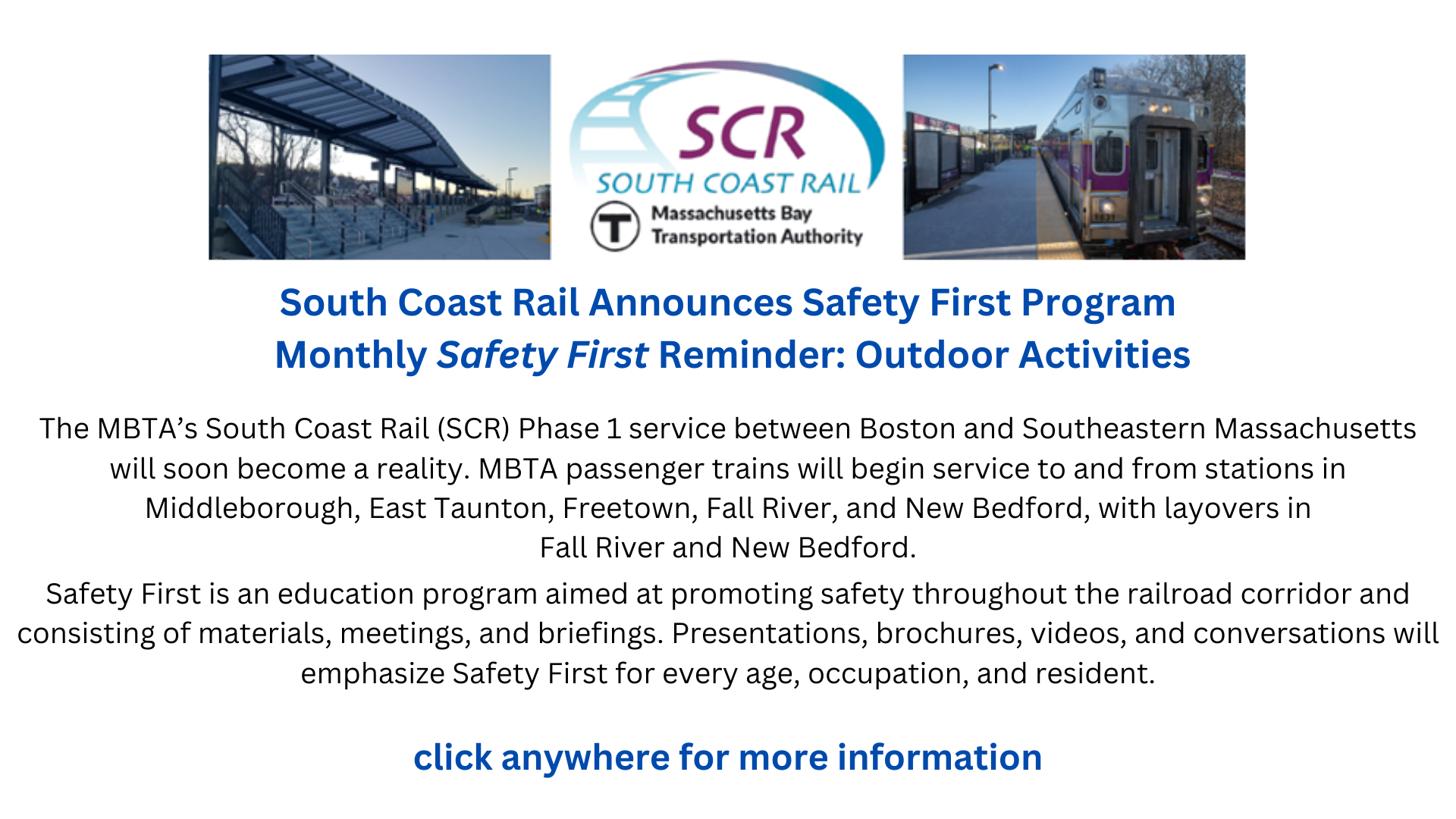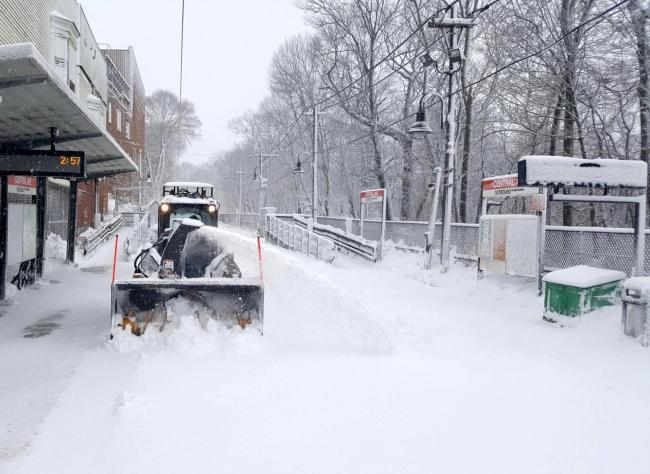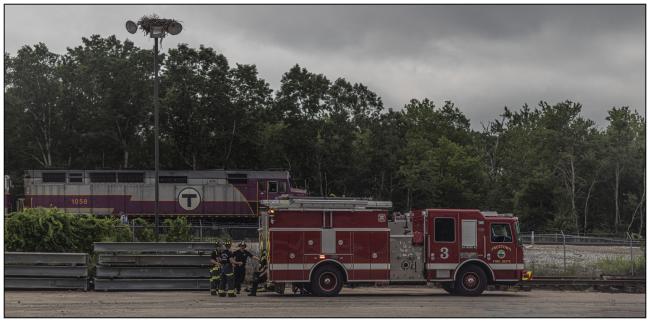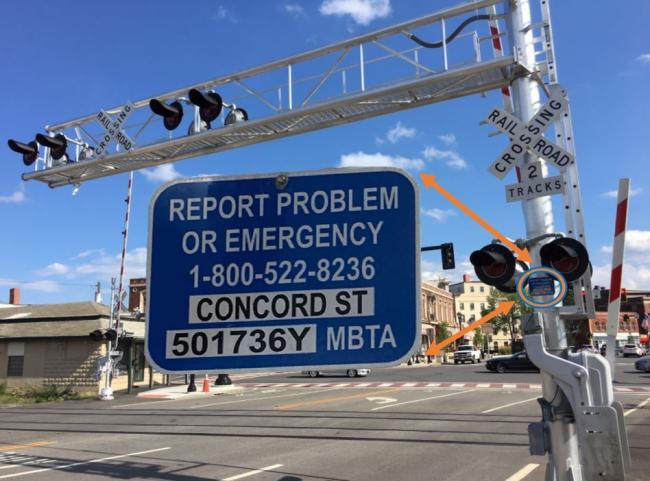South Coast Rail Announces Safety First Program

Monthly Safety First Reminder: Outdoor Activities
Dear Friends of South Coast Rail:
Whether you’re waiting for warmer weather or braving the lingering cold, we want to reach out to outdoor enthusiasts as part of our Right-of-Way (ROW) education program. Wherever you go and whatever you do in the great outdoors, please remember that only trains belong on tracks. Going on the ROW is illegal trespassing and puts your life at risk.
NEVER treat the ROW like a recreational area!
The only activity that should happen on the ROW is safely riding trains as a passenger. Riding all-terrain vehicles, snowmobiling, jogging, bicycling, hunting, or any other activities should never be conducted on railroad property. We encourage all outdoor enthusiasts to check out and share these safety resources from Operation Lifesaver:
- Outdoor Enthusiasts brochures in multiple languages.
- “Sleddin the Right Track” safety video.
- Snowmobile Safety PSA.
- PSA on trespassing.
Put safety first whenever you leave the house, no matter what your destination or plans are.
Safety First is aimed at promoting your safety throughout the railroad corridor. For more information or to request a presentation, send us an email at SouthCoastRail@dot.state.ma.us with “Safety First” in the subject line. Visit the SCR project website, watch our safety videos and Safety Basics vignette, download and share our Safety First fact sheet, and please think Safety First.
Monthly Safety First Reminder: Tracks for Trains, Not Trash or Trespass
Dear Friends of South Coast Rail:
For this month’s Right-of-Way (ROW) safety reminder we’d like to emphasize the dangers of trespassing that can harm the tracks or MBTA’s passengers.
The ROW and all other railroad property are illegal to enter. Besides being a life-threatening risk, the ROW is not designed for any vehicles except trains and authorized railroad vehicles. When dirt bikes, trucks, all-terrain vehicles, or any other unauthorized vehicles enter the ROW, they can damage the gravel ballast that is critical to keeping tracks level and safe for trains. Even with four-wheel drive, vehicles can become stuck and need rescue to prevent possible collisions.
NEVER trespass on the ROW, to ride ATVs or to dump trash!
Thanks to SCR's track improvement work, freight trains can travel up to 25 mph. Test trains that will run during SCR’s testing, commissioning, and simulated service will operate at much higher speeds: from 59 mph initially up to 79 mph. Illegal trespassing and dumping are serious threats, not just to the trespasser, but to everyone:
- When a train collides with debris, not only can it damage the train and the tracks, it could also cause a derailment, threatening the lives of railroad employees and passengers.
- Junk and debris can contaminate the environment, creating a threat to the local community, public health, and anyone tasked with the complicated, dangerous, and expensive cleanup required.
- Even if a trespasser is able to escape the ROW unharmed, there are serious repercussions for trespassing, including legal charges and fines.
Trespassing is a problem that needs to stop. Many agencies are working to prevent track tragedies, from the local to the state, federal, and national levels.
- Railroad dispatchers answer emergency calls to halt train traffic in case there is anything on or near train tracks. Each crossing has a Blue and White Emergency Notification System (ENS) sign with a unique 800 number and crossing identification number. That number should be called even before 911.
- MBTA Transit Police and Massachusetts Environmental Police respond to emergency calls to secure the ROW and catch trespassers and illegal dumpers.
- The Massachusetts Department of Environmental Protection handles violations including illegal dumping and has made a Guide to Filing Environmental Complaints available.
- Operation Lifesaver provides materials, presentations, and numerous other resources promoting safety, with volunteers working nationwide to achieve the goal of saving lives and stopping track tragedies.
We hope you’ll join us and all the agencies above in working to put an end to trespassing by sharing this safety reminder.
Monthly Safety First Reminder: A Safe New Year
Dear Friends of South Coast Rail:
As part of our Right-of-Way (ROW) education program, we are sharing safety reminders on various topics each month. To start 2024 with a focus on safety, we’d like to share important rail safety information.
With the MBTA planning to return Commuter Rail service to Southeastern Massachusetts this year, we want to encourage you to plan ahead and look forward to key rail-related dates, including Rail Safety Week.
Make a resolution to be safe this year!
Safety is a top priority for SCR and the MBTA as a whole. As noted in the 2023 farewell press release, efforts are underway to enhance safety at the Commuter Rail system’s 246 surface grade crossings through road infrastructure improvements as well as technology partnerships with companies like Waze. In order to increase visibility and driver awareness, new lane and fog lines, reflective bollards and road markers, and brighter LED lights on crossing gates are being added to crossings. The MBTA has also collaborated with Waze so that drivers using the app are alerted in advance when they are approaching a Commuter Rail crossing. These features and partnerships are only a small part of the work being done to put safety first.
These measures and public attentiveness are extremely necessary, as there are still track tragedies that need to be prevented. Operation Lifesaver reports the following statistics:
- Over 95% of all railroad fatalities are highway-rail grade crossing collisions and pedestrians trespassing on tracks.
- In the United States, a person or vehicle is hit by a train every 3 hours.
We urge everyone to put safety first every day to prevent track tragedies.
It’s never too early to start planning for safety, so we want to encourage everyone to look forward to this year’s Rail Safety Week. It is typically hosted in September, so please stay tuned for the date announcements and keep September in mind. Rail Safety Week is a collaborative effort among Operation Lifesaver, Inc., state Operation Lifesaver programs, and rail safety partners across the US, Canada and Mexico.
There are many resources available that can help you and your community practice safety, and many different ways to get involved:
- Review Operation Lifesaver’s materials and information about Safety Near Trains.
- Get to know the rails and crossings in your area using SCR’s interactive corridor map.
- Share safety information with family, friends, coworkers, and community members, and commit to putting safety first.
As Phase 1 of South Coast Rail approaches completion, we will provide updates on testing, commissioning, and project milestones in our email updates. Thank you for subscribing, and please stay tuned for details such as service schedules and opening dates as details are finalized.
Safety First is aimed at promoting your safety throughout the railroad corridor. Presentations, brochures, videos, and conversations emphasize ROW safety for every age, occupation, and resident. For more information or to request a presentation, send us an email at SouthCoastRail@dot.state.ma.us with “Safety First” in the subject line. Watch our safety videos and Safety Basics vignette, download and share our Safety First fact sheet, and please think Safety First.
Stay tuned for more information on SCR safety and continue checking the SCR project website. If you have been forwarded this message and would like to receive email updates about SCR, please sign up here. We wish everyone a happy start to the year.
Monthly Safety First Reminder: Winter Conditions
Dear Friends of South Coast Rail:
As part of our Right-of-Way (ROW) education program, we are sharing safety reminders on various topics each month. As our last safety reminder of the year, we want to remind everyone to take winter conditions into consideration to stay safe near the ROW.
Navigating near train tracks, whether on-foot, on a bike, or in a vehicle, requires a high level of awareness and care. This goes doubly so in winter, when snow and ice can affect road and sidewalk conditions as well as visibility.
Be careful when crossing tracks in winter and only cross at designated locations!

Please keep the following tips in mind to stay safe in winter:
- Take it slow: Because snow and ice can increase the risk of slipping or sliding and increase stopping distances, be sure to slow down when crossing the ROW by foot or car.
- Avoid slips and falls: Walking in winter requires extra care. Wear stable shoes with good traction and walk slowly. When exiting or entering vehicles, be mindful of ice and snow.
- Stay aware: Be sure to look for signs and signals that you are approaching a rail crossing. Snow may make it difficult to see striping and indicators on roads.
- Watch for hazards: Wintry conditions can turn dangerous in moments. Be wary of black ice and conditions that impact visibility including whiteout snow, high winds, and fog. Drive carefully by keeping headlights on, driving slowly, and leaving plenty of space between your car and other cars.
- Look both ways and listen: Avoid distractions such as loud music, put away phones, and make sure to carefully observe the area before crossing. Trains are quieter than you think, can come from either direction on any track, and snow and wind can make it even harder to tell when a train is approaching.
- Stay visible: Whether in a vehicle or out, make sure that you are not hidden. If drivers of cars, snowplows, and trains can’t see you, you are in danger.
- Avoid getting stuck: Only cross train tracks if you are sure you can safely get across with adequate clearance on the other side. Cars should stay 15 feet away from the nearest rail.
We also want to share safety reminders with anyone in charge of plowing snow.
- Crossings should be cleared of snow from one side to the other.
- Accumulated piles of snow should be kept off tracks, as large snow accumulation can be a detriment to the grade crossings if not properly managed.
- Plowing vehicles should refrain from stopping on railroad tracks.
- Sand and salt should never be applied within 15 feet of crossings, as they can cause the electrical signals to malfunction.
We recommend reviewing Operation Lifesaver’s Tips for Snow Plow Operators brochure.
If there is anything of concern on or near train tracks, or if you get stuck or stall, find the blue and white sign. All crossings have a Blue and White Emergency Notification System (ENS) sign with a unique 800 number and crossing identification number. Call the number on the ENS sign and provide the unique ID number to report people, vehicles or debris on the tracks, damaged signs or signals, and obstructed views. If there is no ENS sign nearby, call 911.
For more information on how to put Safety First in wintertime, please review the following resources:
- Operation Lifesaver’s All Drivers Brochure in English and Spanish (Español), and Driving Safely page with tips and guidance on how to stay safe.
- Operation Lifesaver’s Pedestrians, Joggers, and Cyclists Brochure in English and Spanish (Español), and Walking Safely page with tips and guidance on how to stay safe.
- The MBTA’s Winter Weather Travel Guide with guidance on how to plan your trips in winter, and the Winter Weather page where service updates around storms will be hosted.
Safety First is aimed at promoting your safety throughout the railroad corridor. Presentations, brochures, videos, and conversations emphasize ROW safety for every age, occupation, and resident. For more information or to request a presentation, send us an email at SouthCoastRail@dot.state.ma.us with “Safety First” in the subject line. Watch our safety videos and Safety Basics vignette, download and share our Safety First fact sheet, and please think Safety First.
Stay tuned for more information on SCR safety and continue checking the SCR project website. If you have been forwarded this message and would like to receive email updates about SCR, please sign up here.
Monthly Safety First Reminder: Illegal Dumping
Dear Friends of South Coast Rail:
As part of our Right-of-Way (ROW) education program, we are sharing safety reminders on various topics each month. This month, we’d like to share a critical reminder that relates not only to safety for train passengers and drivers, but also to public health and environmental safety.
It is illegal to leave any form of debris on the ROW. Railroad tracks, trestles, yards, and equipment are private property, and being on them is trespassing. It is against the law and extremely dangerous to trespass on the ROW.
Only trains should be on the tracks, regardless of how small the item is!
Dumping trash, big or small, creates a clear and severe danger to railroad operators and passengers. Collisions with debris can derail trains. Materials should never be left on the ROW, whether they are large junk such as mattresses or appliances, cleared vegetation, or even small pieces of trash.
In addition to putting lives at risk, illegal dumping can threaten the environment and the health of those who come into contact with dumped materials. Cleanup of any leaked contaminants and broken or damaged materials is complicated and expensive. It’s best for everyone if junk and waste are disposed of properly. Check with your local municipality on how to throw away large or problematic items — never dump material on the ROW.
If there is anything concerning on or near train tracks, the railroad companies must be notified immediately. Each crossing has a Blue and White Emergency Notification System (ENS) sign with a unique 800 number and crossing identification number. Call the number on the ENS sign and provide the unique ID number to report people, vehicles or debris on the tracks, damaged signs or signals, and obstructed views. If there is no ENS sign nearby, call 911.
Illegal dumping should also be reported to the Massachusetts Department of Environmental Protection. Environmental violations handled by MassDEP include unlawful dumping of trash, willful pollution of the environment, unlicensed removal of asbestos, illegal filling of wetlands, and more. A Guide to Filing Environmental Complaints is available.
Safety First is aimed at promoting your safety throughout the railroad corridor. Presentations, brochures, videos, and conversations emphasize ROW safety for every age, occupation, and resident. For more information or to request a presentation, send us an email at SouthCoastRail@dot.state.ma.us with “Safety First” in the subject line. Watch our safety videos and Safety Basics vignette, download and share our Safety First fact sheet, and please think Safety First.
Stay tuned for more information on SCR safety and continue checking the SCR project website. If you have been forwarded this message and would like to receive email updates about SCR, please sign up here.
Monthly Safety First Reminder: First Responders
Dear Friends of South Coast Rail:
As part of our Right-of-Way (ROW) education program, we are sharing safety reminders on various topics every month. Putting Safety First is always important, especially in times of emergency, so we’d like to share information for first responders.
Train tracks should always be treated as live and active unless the railroad owner has been contacted and confirmed that train traffic has stopped. Railroad companies must be notified immediately if there is anything of concern on or near train tracks.
Rail safety and awareness are key to effective emergency responses!

Response teams should be aware that each crossing has a Blue and White Emergency Notification System (ENS) sign with a unique 800 number and crossing identification number. On-scene responders should be prepared to give their dispatch these unique numbers in emergencies to stop or to verify train traffic is stopped prior to accessing the ROW.
Whether responding to incidents or preventing them, always stay alert and stay safe where the roadway crosses train tracks:
- Anticipate your route: Familiarity with the location of railroad tracks in the local area, as well as how to maintain safety near the ROW, is key. Don’t get caught waiting for a train in an emergency.
- Get Out: When responding near train tracks, evacuate the area immediately. Park vehicles at least 15 feet from the nearest rail.
- Get Away: Make sure that everyone is far away from the tracks, at least 15 feet. If a train is approaching, move away from the tracks at a 45-degree angle in the direction the train is approaching to avoid debris.
- Find the Blue and White Sign: Call the number on the Blue and White Emergency Notification System (ENS) sign and share the crossing ID number with the dispatcher.
For more information on how to put Safety First when responding to an emergency, please review the following resources:
- Operation Lifesaver’s First Responder Brochure in English and Spanish (Español), and First Responder Resources page with tips and guidance on how to stay safe.
- Operation Lifesaver’s list of Railroad Emergency Phone Numbers, for contacting the dispatch centers of different railroads.
- Operation Lifesaver’s 30-second PSA on locating the Blue and White Emergency Notification System (ENS) sign and calling the number.
Safety First is aimed at promoting your safety throughout the railroad corridor. Presentations, brochures, videos, and conversations emphasize ROW safety for every age, occupation, and resident. For more information or to request a presentation, send us an email at SouthCoastRail@dot.state.ma.us with “Safety First” in the subject line. Watch our safety videos and Safety Basics vignette, download and share our Safety First fact sheet, and please think Safety First.
Stay tuned for more information on SCR safety and continue checking the SCR project website. If you have been forwarded this message and would like to receive email updates about SCR, please sign up here. We wish everyone a very safe fall and school year!
Monthly Safety First Reminder: Teachers and Parents
As part of our Right-of-Way (ROW) education program, we are sharing safety reminders on specific topics each month. This week is Rail Safety Week, an opportunity to highlight safety and remember to take it to heart every week. With school back in session, we want to reach out to teachers and parents specifically to encourage you to speak with your students and children about putting Safety First. From classroom to home, wherever kids may come across railroad tracks, it is key to make sure they have the knowledge and tools to stay safe.
The MBTA will be testing and commissioning Commuter Rail trains to and from Middleborough, East Taunton, Freetown, Fall River, and New Bedford for the first time in decades. The test trains will travel the corridor, reaching speeds of up to 80 mph, much faster than previous freight trains at 25 mph.
As we approach this exciting milestone, we want to remind everyone who lives by, drives, works, or crosses railroad tracks to prepare for high-speed trains to be a frequent sight in the region. It’s important to remember that only trains should be on the right-of-way. It is illegal and life-threatening to walk on or along the tracks.
Both adults and students should take the following safety information to heart:
- The ONLY safe place to cross train tracks is at designated pedestrian or roadway crossings — obey warning signs and signals posted there.
- Trains are quieter and faster than you think, and the average train traveling 55 mph can take a mile or more to stop.
- Using the railroad ROW to walk, ride bicycles, or for any other recreational purpose is trespassing and extremely dangerous.
Make sure children know how to stay safe around trains!

It is vitally important that kids know what to do in case of an emergency, such as a vehicle getting stuck on the tracks. The following steps should be memorized so that they are prepared:
- Get Out: Leave the vehicle immediately. A school bus driver may open the emergency exit door at the back of the bus. If children are commuting to school in a van, the driver will assist and direct them safely out of the vehicle.
- Get Away: Be sure to stay at least 15 feet away from the tracks.
- Find the Blue and White Sign: Call the number on the Blue and White Emergency Notification System (ENS) sign and share the crossing ID number with the dispatcher. If there is no ENS sign posted nearby, call 911.
The startup of SCR service represents great opportunities and benefits for the region, presenting new issues requiring education and caution. To ensure our safety message is shared effectively, we ask teachers and school staff to show our safety videos as part of classes or assemblies. You can also request a presentation by emailing us at SouthCoastRail@dot.state.ma.us with “Safety First” in the subject line.
The following resources can help put Safety First. Please share these safety practices and resources with students or as a family:
- South Coast Rail’s safety videos for school-age children, including Elementary, Middle, and High school videos.
- Operation Lifesaver’s Student Safety Guide Brochure is available in English and Spanish (Español) with an illustrated safety knowledge test.
- South Coast Rail’s Safety First fact sheet with additional information and resources is excellent for downloading and sharing.
Safety First is aimed at promoting your safety throughout the railroad corridor. Presentations, brochures, videos, and conversations emphasize ROW safety for every age, occupation, and resident. Watch our safety videos and Safety Basics vignette, download and share our Safety First fact sheet, and please think Safety First.
Stay tuned for more information on SCR safety, and continue checking the SCR program website. If you have been forwarded this message and would like to receive email updates about SCR, please sign up here. We wish everyone a very safe fall and school year!
Jean Fox
Director of Community Engagement
South Coast Rail Announces Safety First Program
SouthCoastRail@dot.state.ma.us Safety Videos Safety Basics Vignette
The first rule of Safety First is always to stay clear of the Right-of-Way (ROW). It is very dangerous and illegal to trespass onto the railroad ROW: it is never safe to be near or around railroad tracks. Only cross tracks in designated locations and obey all warning signs and signals. We’ll be sharing these and other safety basics as we near testing and service. Our goal is to bring an understanding of safety rules to every Southeastern Massachusetts city and town.
We are excited to return passenger rail service to your communities for the first time in 60 years! With passenger trains soon to be operating on the ROW, it’s important to remind everyone that safety is MBTA’s top priority throughout the region. While SCR is eagerly awaited, staying safe around tracks and trains is essential. We don’t want you, your family, friends, or pets to end up in a dangerous situation. Keeping the ROW clear for the trains will make your trip by rail safe and reliable, too.
Because the region has not seen passenger trains in decades, people have become comfortable using the ROW for recreation, such as dog walking, ATV and dirt bike riding, running, and taking shortcuts. Sheds, swimming pools, and encampments have been built on and near the tracks, which have also become a dumping grounds for trash and debris. Since 1959, the tracks in this area only saw freight trains a few times a day at relatively low speeds, only recently increasing to 25 mph in certain areas. In the coming months, MBTA test trains will begin operating more frequently at speeds up to 80 mph.
Stay tuned for more information on SCR safety: check the SCR project website and sign up for our email updates. Thank you for remembering to put Safety First.
Jean Fox
Director of Community Engagement

